
The buff ermine is a moth of the family Erebidae. It is sometimes placed in the genus Spilosoma. The species was first described by Johann Siegfried Hufnagel in 1766. It is found throughout the temperate belt of the Palearctic region south to northern Turkey, Georgia, Kazakhstan, southern Siberia, eastern Mongolia, Amur Region, China, Korea and Japan.

Hypercompe is a genus of tiger moths in the family Erebidae erected by Jacob Hübner in 1819.
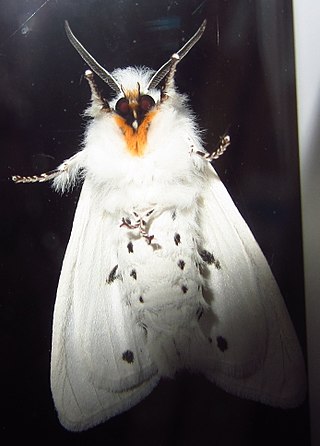
The agreeable tiger moth is one of three species of white tiger moth which are common in the United States. It has pronounced black eyes, white abdomen, and orange "bib" which set it apart from its cousin the Virginia tiger moth. Like its cousin, it tents its wings when at rest.
Hyarias is a monotypic tiger moth genus in the family Erebidae erected by Charles Swinhoe in 1892. Its only species, Hyarias metarhoda, was described by Francis Walker in 1856. It is strictly endemic to the Philippines.

Lacydes is a genus of tiger moths in the family Erebidae erected by Francis Walker in 1855.

Ardices curvata, the crimson tiger moth, is a moth of the family Erebidae. It was first described by Edward Donovan in 1805 and it is found in Australia. The species was formerly included in Spilosoma, but later generic status of Ardices was proved by Vladimir Viktorovitch Dubatolov (2005).
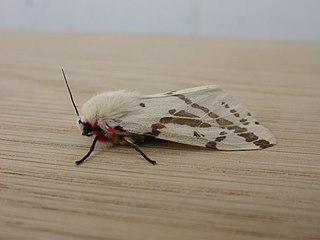
Ardices canescens, the dark-spotted tiger moth or light ermine moth, is a moth in the family Erebidae that is found across most of Australia. It originally was included in the genus Spilosoma, but later the generic status of Ardices was proven.

Spilosoma is a genus of moths in the family Erebidae originally described by John Curtis in 1825. A very heterogeneous group, it is in need of review by the scientific community, as certain species probably need reclassification into their own genera.
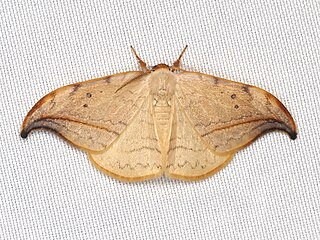
Drepana arcuata, the arched hooktip or masked birch caterpillar, is a moth of the family Drepanidae. The species was first described by Francis Walker in 1855. It is found from Newfoundland to Vancouver Island, south to at least North Carolina, South Carolina and California.
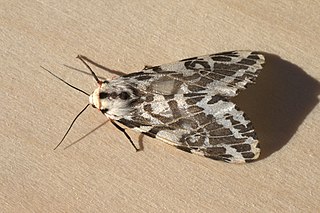
Ardices glatignyi, the black and white tiger moth, is a moth in the family Erebidae that is found in Australia. The species was first described by Le Guillou in 1841. Formerly included in Spilosoma, but later generic status of Ardices was proved by Vladimir Viktorovitch Dubatolov (2005). The larvae are polyphagous, and are known to feed on Lantana camara, Acanthus mollis, and Tradescantia albiflora.

Spilosoma obliqua, the jute hairy caterpillar or Bihar hairy caterpillar, is a moth of the family Erebidae. It is found in south-eastern Afghanistan, northern Pakistan, India, Bhutan, Bangladesh and Myanmar.

Spilosoma curvilinea is a species of moth of the family Erebidae. It was described by Francis Walker in 1855. It is found in Cameroon, Republic of the Congo, Democratic Republic of the Congo, Ghana, Ivory Coast, Kenya, Nigeria, Senegal, Sierra Leone, Sudan, Tanzania, the Gambia and Uganda.
Phragmatobia assimilans, the large ruby tiger moth, is a moth in the family Erebidae. It was described by Francis Walker in 1855. It is found in North America from Nova Scotia to Connecticut, in the east to British Columbia. There are isolated populations in northern Colorado and the Black Hills of South Dakota. The habitat consists of open meadows and moist forests.
Spilosoma danbyi, or Danby's tiger moth, is a moth in the family Erebidae. It was described by Berthold Neumoegen and Harrison Gray Dyar Jr. in 1893. It is found in North America, where it has been recorded from Washington and western Canada from British Columbia to Manitoba.
Spilosoma latipennis, the pink-legged tiger moth, or the red-legged diacrisia, is a moth in the family Erebidae. It was described by Richard Harper Stretch in 1872. It is found in eastern North America, where it has been recorded from Georgia, Indiana, Iowa, Kansas, Kentucky, Maine, Maryland, New Brunswick, New York, North Carolina, Ohio, Ontario, Pennsylvania, South Carolina, West Virginia and Wisconsin.

Spilosoma vestalis, the Vestal tiger-moth, is a moth in the family Erebidae. It was described by Alpheus Spring Packard in 1864. It is found along the coast of western North America, from California north to the Kitsap Peninsula in Washington and western Idaho.
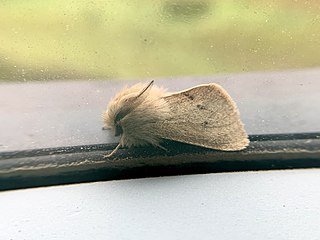
Spilosoma vagans, the wandering diacrisia or wandering tiger moth, is a moth in the family Erebidae. It was described by Jean Baptiste Boisduval in 1852. It is found in western North America, from southern California, southern Utah and central Colorado north to southern British Columbia and south-western Alberta. The habitat consists of drier forests, including open ponderosa pine forests and mixed hardwood-conifer forests.
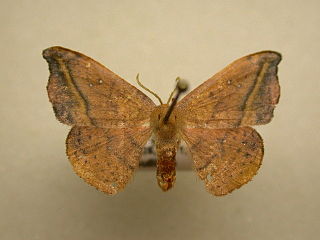
Oreta rosea, the rose hooktip moth, is a moth in the family Drepanidae. It was described by Francis Walker in 1855. It is found in North America, where it has been recorded across boreal Canada to eastern North America. In the north, the range extends to northern Alberta, northern Manitoba and Newfoundland. It is also found east of the Great Plains as far south as Florida and eastern Texas. The habitat consists of moist temperate hardwood forests.














